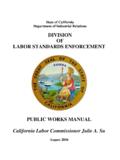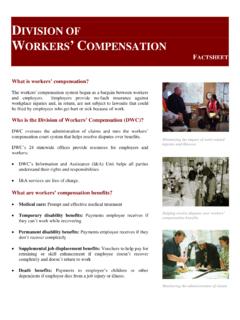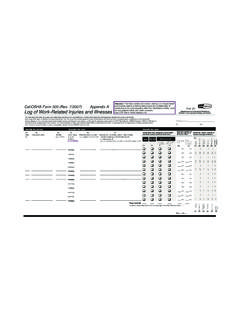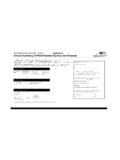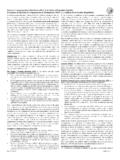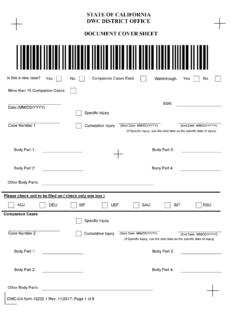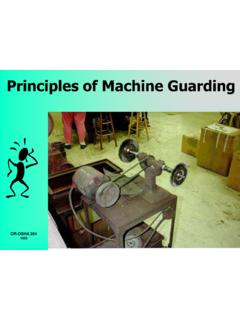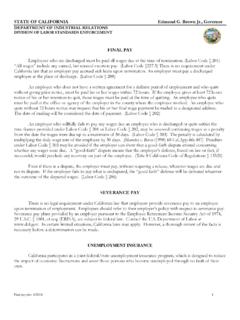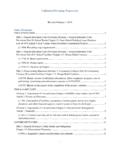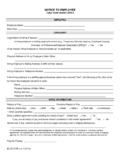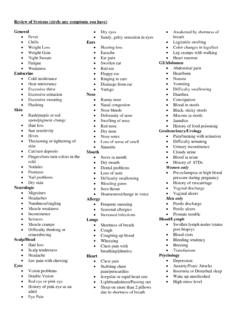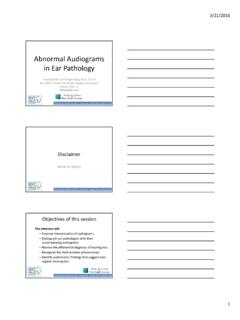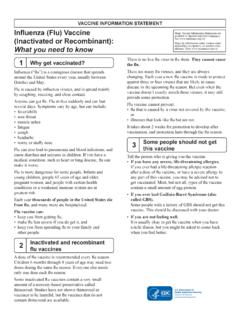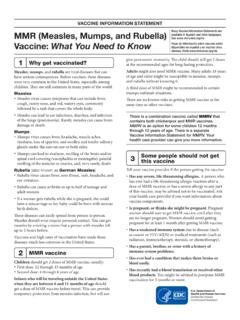Transcription of STANDARDS PRESENTATION Page 1 of 26 TO CALIFORNIA ...
1 STANDARDS PRESENTATION Page 1 of 26. TO. CALIFORNIA OCCUPATIONAL SAFETY AND HEALTH STANDARDS BOARD. TITLE 8, DIVISION 1, CHAPTER 4. Subchapter 7. General Industry Safety Orders Adopt Section 3205 to read: 3205. Shall and Should. [Repealed]COVID-19 Prevention. (a) Scope. (1) This section applies to all employees and places of employment, with the following exceptions: (A) Work locations with one employee who does not have contact with other persons. (B) Employees working from home. (C) Employees with occupational exposure as defined by section 5199, when covered by that section.
2 (D) Employees teleworking from a location of the employee's choice, which is not under the control of the employer. (2) Nothing in this section is intended to limit more protective or stringent state or local health department mandates or guidance. (b) Definitions. The following definitions apply to this section and to sections through (1) Close contact means being within six feet of a COVID-19 case for a cumulative total of 15 minutes or greater in any 24-hour period within or overlapping with the high-risk exposure period defined by this section. This definition applies regardless of the use of face coverings.
3 EXCEPTION: Employees have not had a close contact if they wore a respirator required by the employer and used in compliance with section 5144, whenever they were within six feet of the COVID-19 case during the high-risk exposure period. (2) COVID-19 (Coronavirus Disease 2019) means the disease caused by SARS-CoV-2 (severe acute respiratory syndrome coronavirus 2). (3) COVID-19 case means a person who: (A) Has a positive COVID-19 test as defined in this section; or (B) Has a positive COVID-19 diagnosis from a licensed health care provider; or STANDARDS PRESENTATION Page 2 of 26.
4 TO. CALIFORNIA OCCUPATIONAL SAFETY AND HEALTH STANDARDS BOARD. TITLE 8, DIVISION 1, CHAPTER 4. (C) Is subject to a COVID-19-related order to isolate issued by a local or state health official; or (D) Has died due to COVID-19, in the determination of a local health department or per inclusion in the COVID-19 statistics of a county. (4) COVID-19 hazard means potentially infectious material that may contain SARS-CoV-2, the virus that causes COVID-19. Potentially infectious materials include airborne droplets, small particle aerosols, and airborne droplet nuclei, which most commonly result from a person or persons exhaling, talking or vocalizing, coughing, or sneezing, or from procedures performed on persons which may aerosolize saliva or respiratory tract fluids.
5 This also includes objects or surfaces that may be contaminated with SARS-CoV-2. (5) COVID-19 symptoms means fever of degrees Fahrenheit or higher, chills, cough, shortness of breath or difficulty breathing, fatigue, muscle or body aches, headache, new loss of taste or smell, sore throat, congestion or runny nose , nausea or vomiting, or diarrhea, unless a licensed health care professional determines the person's symptoms were caused by a known condition other than COVID-19. (6) COVID-19 test means a test for SARS-CoV-2 that is: (A) Cleared, approved, or authorized, including in an Emergency Use Authorization (EUA), by the United States Food and Drug Administration (FDA) to detect current infection with the SARS-CoV-2 virus ( , a viral test).
6 (B) Administered in accordance with the authorized instructions; and (C) Not both self-administered and self-read unless observed by the employer or an authorized telehealth proctor. Examples of tests that satisfy this requirement include tests with specimens that are processed by a laboratory (including home or on-site collected specimens which are processed either individually or as pooled specimens), proctored over-the-counter tests, point of care tests, and tests where specimen collection and processing is either done or observed by an employer. (7) Exposed group means all employees at a work location, working area, or a common area at work, where an employee COVID-19 case was present at any time during the high-risk exposure period.
7 A common area at work includes bathrooms, walkways, hallways, aisles, break or eating areas, and waiting areas. The following exceptions apply: STANDARDS PRESENTATION Page 3 of 26. TO. CALIFORNIA OCCUPATIONAL SAFETY AND HEALTH STANDARDS BOARD. TITLE 8, DIVISION 1, CHAPTER 4. (A) For the purpose of determining the exposed group, a place where persons momentarily pass through while everyone is wearing face coverings, without congregating, is not a work location, working area, or a common area at work. (B) If the COVID-19 case was part of a distinct group of employees who are not present at the workplace at the same time as other employees, for instance a work crew or shift that does not overlap with another work crew or shift, only employees within that distinct group are part of the exposed group.
8 (C) If the COVID-19 case visited a work location, working area, or a common area at work for less than 15 minutes during the high-risk exposure period, and the COVID-19. case was wearing a face covering during the entire visit, other people at the work location, working area, or common area are not part of the exposed group. NOTE: An exposed group may include the employees of more than one employer. See Labor Code sections 6303 and (8) Face covering means a surgical mask, a medical procedure mask, a respirator worn voluntarily, or a tightly woven fabric or non-woven material of at least two layers ( , fabrics that do not let light pass through when held up to a light source) that completely covers the nose and mouth and is secured to the head with ties, ear loops, or elastic bands that go behind the head.
9 If gaiters are worn, they shall have two layers of fabric or be folded to make two layers. A face covering is a solid piece of material without slits, visible holes, or punctures, and must fit snugly over the nose , mouth, and chin with no large gaps on the outside of the face. A face covering does not include a scarf, ski mask, balaclava, bandana, turtleneck, collar, or single layer of fabric. This definition includes clear face coverings or cloth face coverings with a clear plastic panel that, despite the non-cloth material allowing light to pass through, otherwise meet this definition and which may be used to facilitate communication with people who are deaf or hard-of-hearing or others who need to see a speaker's mouth or facial expressions to understand speech or sign language respectively.
10 (9) Fully vaccinated means the employer has documented: (A) A person's status two weeks after completing primary vaccination with a COVID-19. vaccine with, if applicable, at least the minimum recommended interval between doses in accordance with the approval, authorization, or listing that is: 1. Approved or authorized for emergency use by the FDA;. 2. Listed for emergency use by the World Health Organization (WHO); or STANDARDS PRESENTATION Page 4 of 26. TO. CALIFORNIA OCCUPATIONAL SAFETY AND HEALTH STANDARDS BOARD. TITLE 8, DIVISION 1, CHAPTER 4. 3. Administered as part of a clinical trial at a site, if the recipient is documented to have primary vaccination with the active (not placebo) COVID-19.
